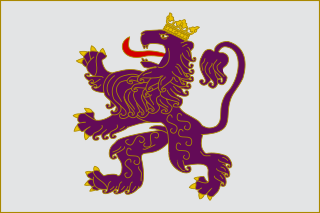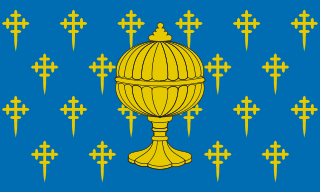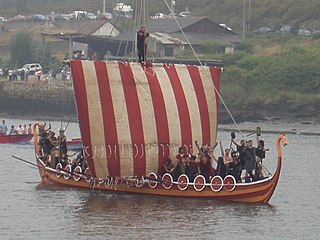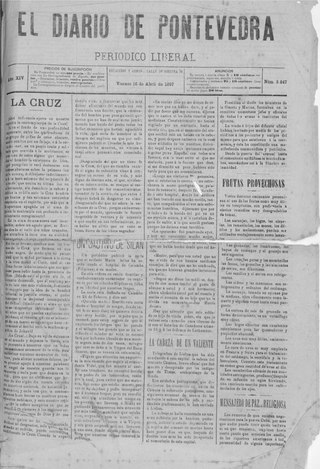Related Research Articles

Galicia is an autonomous community of Spain and historic nationality under Spanish law. Located in the northwest Iberian Peninsula, it includes the provinces of A Coruña, Lugo, Ourense, and Pontevedra.

The Kingdom of León was an independent kingdom situated in the northwest region of the Iberian Peninsula. It was founded in 910 when the Christian princes of Asturias along the northern coast of the peninsula shifted their capital from Oviedo to the city of León. The kings of León fought civil wars, wars against neighbouring kingdoms, and campaigns to repel invasions by both the Moors and the Vikings, all in order to protect their kingdom's changing fortunes.
This is a historical timeline of Portugal.
Bermudo III or Vermudo III was the king of León from 1028 until his death. He was a son of Alfonso V of León by his first wife Elvira Menéndez, and was the last scion of Peter of Cantabria to rule in the Leonese kingdom. Like several of his predecessors, he sometimes carried the imperial title: in 1030 he appears as regni imperii Ueremundo principis; in 1029/1032 as imperator domnus Veremudius in Gallecia; and in 1034 as regni imperii Veremundus rex Legionensis. He was a child when he succeeded his father. In 1034 he was chased from his throne by King Sancho III of Pamplona and forced to take refuge in Galicia. He returned to power, but was defeated and killed fighting against his brother-in-law, Ferdinand of Castile, in the battle of Tamarón.

The Kingdom of Galicia was a political entity located in southwestern Europe, which at its territorial zenith occupied the entire northwest of the Iberian Peninsula. It was founded by the Suebic king Hermeric in 409, with its capital established in Braga. It was the first kingdom that officially adopted Catholicism. In 449, it minted its own currency. In 585, it became a part of the Visigothic Kingdom. In the 8th century, Galicia became a part of the newly founded Christian Kingdom of Asturias, which later became the Kingdom of León, while occasionally achieving independence under the authority of its own kings. Compostela became the capital of Galicia in the 11th century, while the independence of Portugal (1128) determined its southern boundary. The accession of Castilian King Ferdinand III to the Leonese kingdom in 1230 brought Galicia under the control of the Crown of Castile.

BermudoII, called the Gouty, was first a rival king in Galicia (982–984) and then king of the entire Kingdom of León (984–999). His reign is summed up by Justo Pérez de Urbel's description of him as "the poor king tormented in life by the sword of Almanzor and in death by the vengeful pen of a bishop," Pelagius of Oviedo, half of whose Chronicon covers the reign of Bermudo and is highly critical of the king. He accuses Bermudo of imprisoning Bishop Gudesteus of Oviedo in the 990s and blames the attacks of Almanzor on Bermudo's sins.

Oeste Towers is a castle in Catoira, Galicia, Spain. It is located at the head of the Ría de Arousa. It is in the region of Caldas (Pontevedra), in the river Ulla estuary. The towers remaining today are the ruins of Castellum Honesti. Torres del Oeste has been declared a national monument.
Menendo González was a semi-autonomous Duke of Galicia and Count of Portugal (997–1008), a dominant figure in the Kingdom of León. He was the royal alférez, the king's armour-bearer and commander of the royal armies, under Vermudo II, and he continued to hold the position until his death. He became the tutor (1003) and ultimately father-in-law of Vermudo's successor, King Alfonso V. He maintained peaceful diplomatic relations with the Caliphate of Córdoba until 1004, after which there was a state of war.
Ulv Galiciefarer, aka Jarl Galizur-Ulfric, was a Danish jarl, a Viking chieftain who became famous for his raids, looting and pillaging the lands of Galicia in the early eleventh century, perhaps in 1028 or 1048, during the reign of Bermudo III and Ferdinand I of Leon. According to Saxo Grammaticus and the Knýtlinga saga, Galicieulv was grandfather of Boedil Thurgotsdatter, the wife of Eric I of Denmark.
Suero Gundemáriz was a Leonese count in the region of Galicia, notable mainly for leading the region in rebellion. He was married to Teodegonza, a relative of Rudesind, founder of the monastery of Celanova. He was probably a brother of Piniolo Gundemáriz and thus an uncle of Count Gundemaro Pinióliz.

Viking activity in the Iberian peninsula seems to have begun around the mid-ninth century as an extension of Viking raids on and establishment of bases in Frankia in the earlier ninth century. While connections between the Norse and Eastern Islamic lands were well-established, particularly involving the Rus' along the Volga and around the Caspian Sea, relations with the Western edge of Islam were more sporadic and haphazard. Although Vikings may have over-wintered in Iberia, no evidence has been found for trading or settlement. Indeed, the Iberian peninsula may not have offered particularly wealthy targets, in the ninth to tenth centuries. Sporadic raiding continued until the end of the Viking Age.

Viking Festival of Catoira is a secular festival which has been celebrated in Catoira, Spain, every first Sunday in August since 1961, in the surroundings of Castellum Honesti, currently known as Torres de Oeste fortress. It is held to commemorate Catoira's role in defending Galicia against the Vikings, who attempted to plunder the treasure held in the Cathedral of Santiago de Compostela, and also to reenact the Viking invasions that took place there a thousand years ago.
Luis Castro Lois is a Spanish footballer who plays for Polvorín FC as a left back.

The Monument to the Heroes of Puente Sampayo is a memorial and sculptural group created by the Spanish sculptor Julio González Pola, in Pontevedra, Spain.

The Diario de Pontevedra is a Spanish newspaper published in the city of Pontevedra since 1968, owned since 1999 by the El Progreso group, which also publishes El Progreso de Lugo.

The former College of the Jesuits is an 18th century baroque building located in Sarmiento Street in the heart of the old town of Pontevedra, Spain. A secondary educational institution founded by the Jesuits in 1695, the building is known today as the Sarmiento Building and is one of the seats of the Pontevedra Museum.

Galicia irredenta or Galicia estremeira, also spelled as Galiza irredenta and Galiza estremeira and also known as Faixa Leste or Franxa Leste, is a term used for all Galician-speaking territories located outside of Galicia. These are all located in Spain, in either Asturias or Castile and León. These territories are sometimes divided into three subregions: El Bierzo, Eo-Navia and As Portelas.
In the run up to the 2023 Spanish local elections, various organisations carry out opinion polling to gauge voting intention in local entities in Spain. Results of such polls for municipalities in Galicia are displayed in this article. The date range for these opinion polls is from the previous local elections, held on 26 May 2019, to the day the next elections will be held, on 28 May 2023.

The Pontevedra Provincial Hospital is a building dating from 1897, located in the city centre of Pontevedra, Spain.

Xosé Artiaga Barreira, is a Galician painter, engraver, photographer and multimedia artist, as well as teacher of drawing.
References
- 1 2 Narvaiz, Silvia Miguens (2010-01-01). Breve historia de los piratas (in Spanish). Ediciones Nowtilus S.L. ISBN 978-84-9763-709-1.[ permanent dead link ] p.136
- 1 2 Risco, Vicente (1978). Historia de Galicia (in Spanish). Editorial Galaxia. p.81
- ↑ Catoira, T. Hermida | (2017-01-22). "Hallan en Dinamarca la presunta tumba del vikingo Ulf que asaltó tierras arousanas en el siglo XI". Faro de Vigo. Retrieved 2020-12-29. (in Spanish)
- ↑ Frutos, Pedro de (1981). Leyendas gallegas: De la iniciación al mitogenismo (in Spanish). Tres, Catorce, Diecisiete. ISBN 978-84-85208-20-3. p.81
- ↑ Pontevedra, Diario de (2020-02-25). "Galiza Ulf, el lobo vikingo". Diario de Pontevedra (in Spanish). Retrieved 2020-12-29.
- ↑ Christys, Ann (2015-08-27). Vikings in the South: Voyages to Iberia and the Mediterranean. Bloomsbury Publishing. ISBN 978-1-4742-1377-6.
- ↑ Lugo, El Progreso de (2018-08-13). "En busca del castillo de Labio". El Progreso de Lugo (in Spanish). Retrieved 2020-12-29.